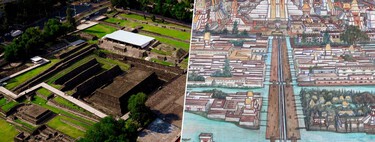2024 is being a good year for lovers of ancient civilizations. A few weeks ago, several treasures and mummified remains were found in Egypt in a rock-cut tomb. A few thousand kilometers to the west, the protagonists are the Mayans. The reason is that, due to the construction works of the ambitious Mayan Train, millions of material goods and even palaces belonging to this civilization have been found.
And it is something that can be crucial to understand a little more about this Mesopotamian civilization of which there are still many mysteries to be solved.
The Mayan Train. The Government’s objective is for the Mayan Train to be the new backbone of Mexico. It will cross the states of Chiapas, Tabasco, Campeche, Yucatán and Quintana Roo and is expected to be used during the day as a passenger train and at night as a freight train.
It will have 15 stations and has several sections for a total of 1,525 kilometers. The good thing is that 95% of the route will use already deployed infrastructure. And in the new works, archaeologists are finding authentic Mayan treasures.
Colossal. That the Mayans are fascinating is no secret. They were one of the most developed cultures of antiquity, with more than 3,500 years of history when their empire began to decline. They were masters in many areas, but especially in mathematics, agriculture, writing and astronomy.
During the infrastructure works of the Mayan Train, archaeologists from the INAH (National Institute of Anthropology and History of Mexico) were discovering various remains from the past, such as a choker from pre-Hispanic times or a canoe of which samples have been sent to the Louvre for study. Several bone remains belonging to humans and animals were also found. The total numbers are staggering.
Diego Prieto Hernández, director of INAH, he claimed In January of this year, “more than 1.4 million ceramic fragments, more than 50,000 movable and immovable property, such as palaces and structures, have been discovered, constituting the largest archaeological treasure found in recent decades in Mexico.” Literally, discovered a 25 meter high pyramid on an 80 meter long acropolis.
Light on the past. According to Diego, taking advantage of the Mayan Train works is “the most important research project that has ever been carried out in the Mayan region of Mexico.” And it is no wonder, since the route is made up of several sections and in all of them elements of great value belonging to the Mayans are being found.
One of them is an urn with the image of the god of corn. It is a raw clay pot that contains the mortal remains of a person and has several inscriptions on the body, one being the Mayan symbol. ik which alludes to the wind and the divine breath. In addition, there is the figure of the corn god himself in his representation of an ear in the growth stage.
Corn is a fundamental part of Mayan mythology, since the gods created men with mud, wood and corn dough, only the latter surviving. In addition, the vessel was next to another with ornamentation on the sides that simulates the thorns of a ceiba tree, a sacred tree both for the ancient Mayans and for some natives today.
All of this helps researchers create connections with the past. For example, they can theorize that the area where the choker was found could be an important political focus because these luxury objects were used in diplomatic exchanges. And a solar disk at Chichén Itzá suggests that it was a religious or study center.
Controversies. Now, all that glitters is not gold. Apart from the controversies originated by the indigenous voting system and the environmental impactwith Greenpeace protests tying themselves to machinery to stop deforestation in one of the areas, The Washington Post published a article called ‘Destroying Mayan treasures to build a tourist train’.
It reflects the contradiction of the project, since it is something political (President Andrés Manuel López Obrador wants it to be completed this year) and there are archaeologists destined for this project who marvel at each discovery without taking into account that they are only there for obligation and that the paths will unfold whatever they find.

and defenses. The INAH defended of this article stating that the country’s heritage is being protected, but the same institution He delivered letters in 2020 and 2021 stating that “an unknown number of national assets” had been destroyed. That line is also supported by the anthropologist Juan Manuel Sandoval, who attacked his colleagues in a document 75 pages in 2022.
Beyond all this, the INAH states that it intends to preserve these treasures, which will be exhibited in museums such as the Puuc Archaeological Museum, as well as the Yucatan History Museum that will be inaugurated soon. And Diego affirms that the Institute’s ultimate intention is to “conserve archaeological materials and sites for future generations.”
Images | INAH TV
In Xataka | Almería keeps one of the greatest archaeological secrets in Spain. And now it presents us with a genetic enigma















![[Img #74661]](https://thelatestnews.world/wp-content/uploads/2024/12/The-power-of-ultrasound-300x200.jpg)
Add Comment